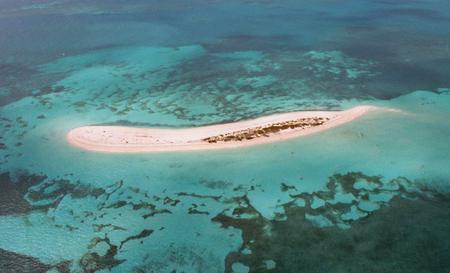There is a lot more to Florida's Dry Tortugas National Park than meets the eye.
Billions and billions
Number of zooxanthellae, the tiny single-celled algae that give coral polyps their vivid colors as well as most of their energy. Without the colorful zooxanthellae, the park's stunningly beautiful coral reefs -- the southern tip of the world's third-largest coral reef system (after Australia's Great Barrier Reef and Belize) -- would appear bleached and colorless.
16 million or so
Bricks used to build Fort Jefferson, which was constructed (though never completed) on Garden Key in the mid-1800s to protect the vital shipping channel between the Dry Tortugas and the Florida Keys. The park's initial designation (1935-1992) was Fort Jefferson National Monument.
217,968
Objects, specimens, photographs, and archival documents in the park's museum collection as of FY 2008.
80,000+
Sooty terns nesting at Dry Tortugas between March and September. Bush Key, the island closest to Garden Key/Fort Jefferson, is the only known sooty tern nesting area in the U.S. At least 298 other bird species have been documented in the park. Some of them, including brown pelicans, cormorants, herons, and egrets, live there year round.
52,011
Recreational visitors in 2009. This park is inconvenient and expensive to visit, being located 70 miles from Key West and accessible only by boat or seaplane. Only two other National Park-designated NPS units in the 48-state U.S. (Isle Royale National Park and North Cascades National Park) attract fewer visitors.
13,003
Overnight stays by 3,394 campers in 2009. Campers must pack carefully and efficiently. There is no place in the park to get groceries, fresh water, or fuel of any type, and both of the concessionaire-operated ferries have strict weight limits on gear (40 pounds on the Sunny Days Fast Cat and 60 pounds on the Yankee Freedom II).
$435+
Fare for a full-day seaplane excursion, which features a speedy trip to the park (about 40 minutes) and 6.5 hours of island time for sightseeing and snorkeling . The ferry option, which costs only $145-$160, takes two hours or so each way and provides around 4 hours of island time. Some people with deep pockets and lots of leisure time charter sailboats.
nearly 300
Approximate number of shipwrecks in the Dry Tortugas. Being close to busy shipping lanes that can be tricky to navigate because of strong currents and storms, the coral reefs and sandy shoals of the Dry Tortugas have been claiming vessels ever since Spanish explorer Ponce de Leon discovered the islands (and named them) in 1513.
152 feet
Height of the Loggerhead Key lighthouse. Constructed of brick in the 1850s, this massive structure has walls that are 8 feet thick. Still in use today, it is now powered by solar panels and fully automated.
$125
Approximate disposal cost for a single chug. The homemade boats that illegal Cuban migrants arrive in -- called chugs or chug-chugs -- must be removed to the mainland. It used to cost $600 per chug to have a private contractor perform this task, but now the chugs are hauled to Key West on the park's own vessel, the 110-foot R/V Fort Jefferson.
56 days
Typical incubation period for sea turtle eggs. Loggerhead, leatherback, Atlantic ridley, hawksbill and green turtles all inhabit these waters. The low, sandy islands of the Dry Tortugas (tortugas is Spanish for turtles) provide nearly ideal nesting grounds for females that crawl ashore to lay their eggs, usually during full-moon nights, between April and September.
mid-50s
Lowest temperatures (degrees Fahrenheit) that visitors are likely to encounter in the early morning during the coldest winter months. Winter temperatures are moderated by the warm Gulf waters surrounding the Dry Tortugas. Summer temperatures run into the mid-80s.
46 square miles
Area of the no-take, no-anchor Dry Tortugas Research Natural Area established in the Dry Tortugas in 2007 to provide a sanctuary for species affected by overfishing and habitat degradation. This RNA and the adjacent Tortugas Ecological Reserve in the Florida Keys National Marine Sanctuary together constitute the largest no-take marine reserve in the continental U.S.
36
Case incidents in 2008 involving Type I and Type II offenses. These incidents included 12 Type I offenses (all involving illegal immigration or human smuggling) and 22 Type II offenses, mostly for resource violations such as entering closed special protection zones, overboard discharge, wildlife violations, or groundings.
30
Maximum number of commercial use authorization permits (CUAs) that can awarded for a given year at Dry Tortugas. The CUAs awarded for 2010 include 14 for guide fishing, 9 for wildlife viewing, 4 for diving/snorkeling, 2 for sailing, and one reserved for a one-time use. This tally doesn't include film and special use permits.
23
Volunteers who worked in the park during FY 2008. Their 5,859 hours of service included 3,386 hours in maintenance, 840 hours in campground hosting, 688 hours in interpretation, 334 hours in General Management, 249 hours in resource management, 161 hours in Protection/Operations/Law Enforcement, 113 hours in training, and 88 hours in Administration.
10 feet above sea level
The highest natural surface in the Dry Tortugas. It's on Loggerhead Key.
5
Hurricanes that impacted Dry Tortugas during a 14- month period in 2004 and 2005. This was the highest incidence in at least 130 years.
1
Number of submarines that have spent the night at historic Fort Jefferson. On May 25, Mote Marine Laboratory dispatched an autonomous underwater vehicle (AUV) named Waldo to look for Deepwater Horizon oil spill impacts in the waters northwest of Key West. After going astray because of strong currents, the little robot was retrieved about six miles from Garden Key/Fort Jefferson and hauled ashore there for overnight storage. Waldo was flown to Key West and replaced with an AUV blandly dubbed UD134.
0.0607
Percentage of Dry Tortugas' total acreage that is not underwater. Dry land accounts for just 39.28 acres of the 64,701-acre park.
0
Number of trash receptacles the park provides. All boaters, campers, and other visitors must pack out their own trash .




Add comment